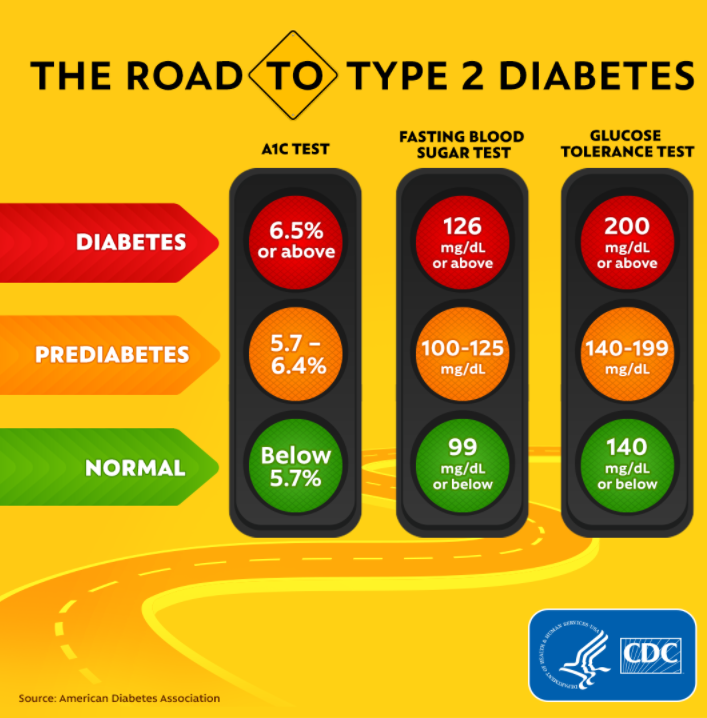Here is an infographic from the CDC:
If you have prediabtes, then consider joining:
National Diabetes Prevention Program from the CDC
Why Participate? from the CDC
Research shows that CDC-recognized lifestyle change program participants who lost 5-7% of their body weight and added 150 minutes of exercise per week cut their risk of developing type 2 diabetes by up to 58% (71% for people over 60 years old).
Even a decade later, program participants were one-third less likely to develop type 2 diabetes than individuals who did not join a program.
The program can also lower your risk of having a heart attack or stroke, improve your health, help you feel more energetic, and even reverse your prediabetes diagnosis.
In this post, I link to and excerpt from The Curbsiders‘ #309 USPSTF Quick Update: Prediabetes & Type 2 Diabetes Screening With Dr. Chien-Wen Tseng
DECEMBER 6, 2021 By Dr. PAUL WILLIAMS
All that follows is from the above outstanding resource.
Summary
Sweeten your day with a review of the updated 2021 USPSTF Prediabetes and Type 2 Diabetes screening guidelines with expert guest Dr. Chien-Wen Tseng! We review the new screening recommendations, assess different testing modalities, talk through screening intervals, and emphasize other risk factors that impact screening!
USPSTF Update: Prediabetes & DM Screening Pearls
- The USPSTF recommends screening for prediabetes and Type 2 diabetes in adults ages 35 to 70 who have overweight or obesity.
- Defining Adult Overweight & Obesity from the CDC
- “Weight that is higher than what is considered healthy for a given height is described as overweight or obesity. Body Mass Index (BMI) is a screening tool for overweight and obesity.”
- “BMI is a person’s weight in kilograms divided by the square of height in meters. A high BMI can indicate high body fatness.
- “To calculate BMI, see the Adult BMI Calculator or determine BMI by finding your height and weight in this BMI Index Chart
- “BMI does not measure body fat directly, but BMI is moderately correlated with more direct measures of body fat obtained from skinfold thickness measurements, bioelectrical impedance, underwater weighing, dual energy x-ray absorptiometry (DXA) and other methods 1,2,3. Furthermore, BMI appears to be strongly correlated with various adverse health outcomes consistent with these more direct measures of body fatness 4,5,6,7,8,9.”
- Prediabetes – Your Chance to Prevent Type 2 Diabetes from the CDC.
- Diabetes Tests from the CDC.
Result* A1C Test Fasting Blood Sugar Test Glucose Tolerance Test Random Blood Sugar Test Diabetes 6.5% or above 126 mg/dL or above 200 mg/dL or above 200 mg/dL or above Prediabetes 5.7 – 6.4% 100 – 125 mg/dL 140 – 199 mg/dL N/A Normal Below 5.7% 99 mg/dL or below 140 mg/dL or below N/A - “If your doctor thinks you have type 1 diabetes, your blood may also tested for autoantibodies (substances that indicate your body is attacking itself) that are often present in type 1 diabetes but not in type 2 diabetes. You may have your urine tested for ketones (produced when your body burns fat for energy), which also indicate type 1 diabetes instead of type 2 diabetes.”
- One of the biggest changes from the 2015 recommendation is lowering the age of screening initiation from 40 years old to 35 years old.
- Screening can be completed with one of the following: 1) Hemoglobin A1c 2) Fasting glucose 3) Glucose tolerance test.
- If initial screening is normal, a reasonable interval for repeat screening is 3 years.
- Screening should be considered at a lower BMI >23 for Asian American patients and at an earlier age if the patient is from a population with a disproportionately high prevalence of diabetes.
National Diabetes Prevention Program from the CDC
Why Participate? from the CDC
Research shows that CDC-recognized lifestyle change program participants who lost 5-7% of their body weight and added 150 minutes of exercise per week cut their risk of developing type 2 diabetes by up to 58% (71% for people over 60 years old).
Even a decade later, program participants were one-third less likely to develop type 2 diabetes than individuals who did not join a program.
The program can also lower your risk of having a heart attack or stroke, improve your health, help you feel more energetic, and even reverse your prediabetes diagnosis.





